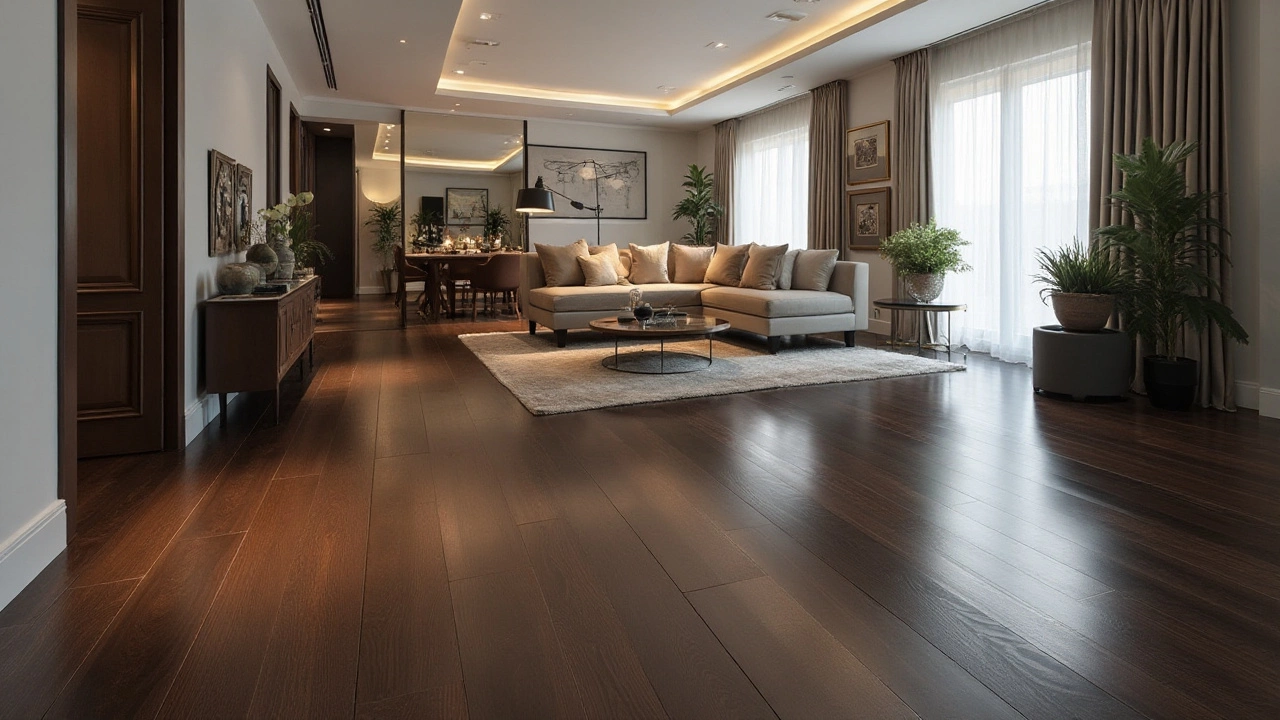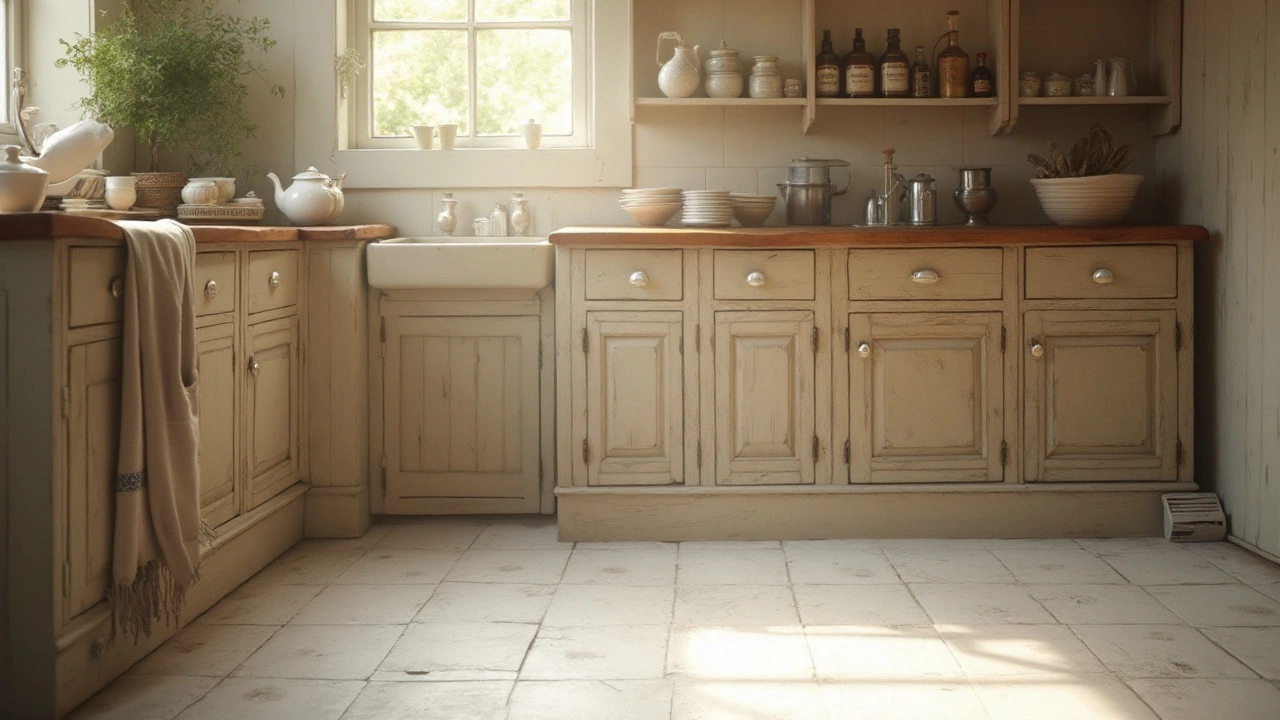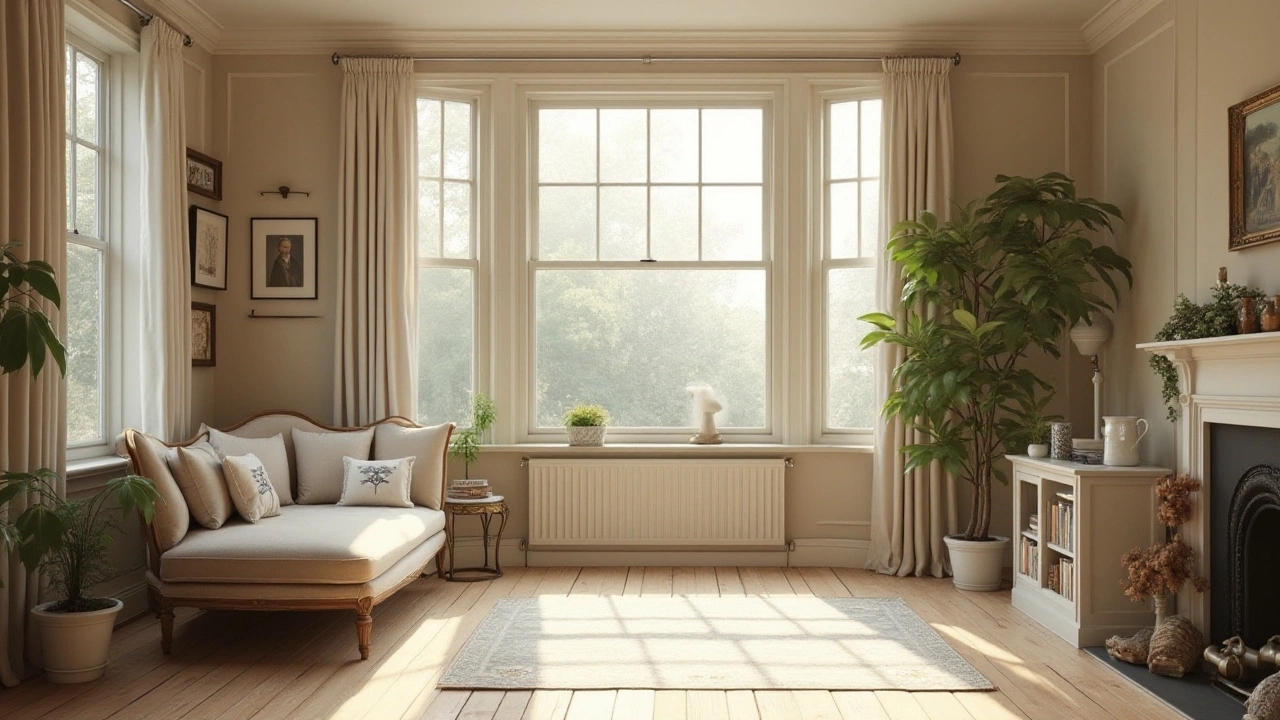When pondering flooring options, one of the most frequent questions is what color will keep things looking spick and span. Color psychology suggests that certain hues can trick the eye into perceiving cleanliness, making your home appear tidier than it is. Light, airy tones like whites and beiges are often recommended for their dirt-concealing abilities, while dark shades bring an air of luxury.
However, the secret to choosing the cleanest looking floor doesn't just lie in color alone. Consideration of material, texture, and finish play essential roles too. Picking the perfect floor involves blending aesthetics with practical maintenance, so let's delve into the choices that offer the ideal balance of style and spotless presentation.
- The Psychology of Color and Cleanliness
- Best Light Flooring Options
- Dark Floors: Pros and Cons
- Natural Tones and Their Benefits
- Material Matters: How Texture Affects Cleanliness
- Finishing Touches for a Cleaner Look
The Psychology of Color and Cleanliness
Colors wield a profound influence on our psyche, shaping not just our moods but also our perceptions of spaces around us. When it comes to home interiors, color choices can subtly suggest the level of cleanliness and order. Light shades, such as white, beige, and pastels, often evoke a sense of openness and purity. This perception stems from centuries of color associations where light hues have signified tranquility and sanitation. In modern decor, these colors are popular for flooring colors because they naturally reflect more light than darker shades, which can make spaces feel larger and airier, ultimately radiating a sense of cleanliness.
The way light interacts with surfaces also plays a significant role. Floors in lighter tones effectively conceal dust and minor imperfections, giving the illusion of a spotless environment. For instance, a lightly speckled beige floor can hide dirt better than a pristine black counterpart, which tends to show every speck. The science backing this comes from the way our eyes adjust – darker colors absorb more light, casting deeper shadows that highlight irregularities.
Interestingly, cultural contexts also influence color preferences in relation to cleanliness. In Western societies, white stands as the epitome of cleanliness – from hospital walls to pristine floors, symbols of hygiene and sterility are deeply rooted in white. This enduring association has much to do with early sanitation practices when the smallest sign of dirt was painted starkly visible against a white backdrop. A famous psychologist once noted, "Colors, like features, follow the changes of the emotions," drawing attention to how our surroundings affect emotional and perceptional understanding.
Yet, it isn't all about light colors. While darker earth tones such as deep browns and charcoals exude warmth and elegance, they're often thought of as sophisticated choices that require more maintenance. These flooring colors carry elegance and depth but may show dirt and scratches more readily. Psychologically, they introduce a sense of depth or groundedness, offering a comforting, protective vibe often appreciated in more formal or intimate settings.
"Design is not just what it looks like and feels like. Design is how it works." – Steve JobsThis quote holds relevance in flooring design, where both aesthetic appeal and practical functionality determine how welcoming and clean a space feels.
Understanding how color affects our perception of cleanliness can serve as a powerful tool when planning your interiors. The psychology of color is not merely decorative; it's a blend of artistry and science, influencing our daily living environment. By carefully selecting flooring tips focused on color, you can create spaces that not only look beautiful but feel inherently clean. Whether you lean toward the serenity of light floors or the richness of darker tones, knowing how these colors influence perception can lead to a well-informed and satisfying decision.
Best Light Flooring Options
Choosing the right flooring can transform any space, especially when you opt for light flooring options. These lighter hues not only magnify the perception of space, making a room feel larger and more open, but they also come with the practical advantage of concealing dust and debris. Speaking of light shades, think whites, creams, and pastels. They are remarkably effective at masking the everyday specks that inevitably find their way onto your floors, particularly in busy households or those with children and pets.
One of the perennial favorites for light flooring is natural maple wood. Its pale color coupled with subtle grains not only brightens up a room but also adds an elegant sophistication. If you prefer something even more durable, consider porcelain tiles in light shades. These tiles not only capture the essence of luxury but also resist scratches and stains, making them an excellent choice for high-traffic areas. Many homeowners revel in the easy maintenance of these tiles, which require little more than regular sweeping and an occasional mop.
When contemplating a trendier look, luxury vinyl can provide a very convincing wood or stone appearance at a fraction of the cost and upkeep. It's available in an array of flooring colors and finishes that mimic light oak or bleached pine, all the while offering resilience against moisture and wear. As sustainability becomes more of a priority, bamboo emerges as an eco-friendly light flooring option. Naturally light in color, bamboo floors bring in the richness of hardwood with a significantly smaller ecological footprint.
Cary Hagler, an esteemed interior designer, once said, "Light floors function as a canvas, allowing the furnishings and textiles to truly pop while maintaining an effortless flow of light throughout your home."
Another compelling option is pale carpeting, which immediately makes a room feel cozy yet remains elegant. With modern advancements, many light carpets are now stain-resistant and can be treated to withstand common spills and stains, a boon to busy families or anyone fond of entertaining. A less traditional choice, yet equally impactful, is the light-hued concrete floor. Polished to a high sheen, this option plays with textures and finishes, pairing durability with a modern aesthetic.
A comparison of costs between materials may be useful for decision-making purposes. Below is a table that outlines the average price range per square meter for some popular light flooring choices:
| Material | Price Range (per square meter) |
|---|---|
| Maple Wood | £50 - £70 |
| Porcelain Tiles | £30 - £50 |
| Luxury Vinyl | £15 - £35 |
| Bamboo | £25 - £45 |
| Concrete | £40 - £60 |
To sum up, the beauty of light flooring lies in its versatility and ability to adapt to an array of interior styles while offering a bright, clean canvas that showcases the room's features. When selecting your floor, consider the room's function, the associated maintenance, and how the floors will harmonize with your home's aesthetic. Whether you choose wood, tile, or even carpet, light floors remain a timeless foundation for any design.

Dark Floors: Pros and Cons
Embracing dark flooring colors can transform a space with a sense of elegance and a modern feel. These deep hues often add drama and sophistication, creating a bold backdrop that stylishly contrasts with lighter walls and furniture. Many homeowners opt for dark floors for their ability to make a statement, lending a touch of luxury that lighter floors might not convey as effectively. In large open spaces, dark floors can ground a room, making it feel warm and inviting. This ability to balance vast areas gives them an appealing charm that naturally attracts those aiming for a sleek and upmarket ambiance. Whether it's a dark walnut or rich mahogany, these shades can enhance the visual depth of any room, giving the home a grounded and cozy vibe.
Despite these aesthetic benefits, dark floors do come with their share of challenges. One of the most significant drawbacks is their tendency to showcase dust, dirt, and pet hair more readily than lighter floors. The nature of the color spectrum means that any light particles are more visible against a dark background, leading to potentially more frequent cleaning. This is especially true in households with pets or children, where crumbs and tiny debris seem to multiply mysteriously. It isn't uncommon to hear complaints about needing to sweep or mop daily. There is also an anecdotal observation that in rooms lacking sufficient natural light, dark floors can make spaces feel smaller, adding an unwelcome sense of scarcity to already confined quarters.
The durability of dark flooring materials is another consideration. While opting for materials like dark-stained hardwood or stone might offer longevity, they come at a premium compared to other options such as laminated or vinyl planks. This can be a pivotal factor for budget-conscious homeowners. Each material, whether natural or engineered, interacts with the dark color palette differently, potentially affecting upkeep and longevity. According to designer Jane Atwood,
"The key to enjoying the beauty of dark flooring is pairing it with a finish that makes maintenance as easy as the aesthetics."Thick poly finishes can mitigate scratching and scuff marks, preserving the original luster of the flooring.
If you're attracted to the sleek look of dark floors, there are strategic design choices that can alleviate some of the pitfalls associated with them. Installing strong lighting, particularly if natural light is scarce, can prevent the room from feeling dim. Incorporating light-colored area rugs can break up the visual monotony while adding texture and warmth. Additionally, using mixed materials such as metal or glass accents can enhance the modern touch while diffusing light artiicially. A proactive approach to cleaning routines and choosing the right upholstery can significantly optimize the experience of living with dark floor designs, marrying style with practicality in seamless harmony.
Natural Tones and Their Benefits
Embracing natural tones in your flooring colors can be a clever strategy for maintaining a clean look with minimal effort. Natural hues like oak, walnut, or even some earthy grays have an innate ability to blend with their surroundings, effectively masking dust and dirt. This characteristic makes them a popular choice among homeowners who desire beauty without constant upkeep. The organic aspects of these colors contribute a sense of warmth and calmness to a room, creating not only a visually appealing space but also a homely atmosphere.
One impressive aspect of natural-toned floors is their adaptability to different interior design styles. Whether your home exudes a rustic charm, leans towards modern minimalism, or sits somewhere in between, floors with natural hues blend seamlessly. They provide a calm backdrop against vivid furniture or art, highlighting these elements without overwhelming the space. This flexibility makes them suitable for any room, from bustling kitchens to quiet bedrooms. It’s essential to note that while these colors don’t show every speck of dust, they aren’t entirely forgiving of larger debris, so regular sweeping does help.
Materials like wooden floors in natural colors not only offer aesthetic benefits but also come with functional perks. Hardwood is renowned for its durability, often sustaining its beauty for decades when properly maintained. For those conscious about their carbon footprint, opting for sustainably sourced wood can ease environmental concerns. An interesting statistic is that wood flooring options like bamboo, which is technically a grass, regenerate faster than traditional wood and are gaining popularity for their eco-friendliness.
Aside from wood, other materials like natural stone tiles also provide a clean appearance with added vigor. Stones like travertine or limestone have varied patterns that naturally disguise minor blemishes. Often, these materials require less water to clean, reducing mold and mildew build-up compared to carpets. A significant advantage is that natural stones are less prone to trapping allergens, making them an excellent choice for households with allergy sufferers.
"Natural materials bring warmth and authenticity that often helps ground a space," says renowned interior designer, Nina Campbell. "While they don't replace the need for regular cleaning, they certainly make things appear more forgiving to the eye."
When considering the costs, natural floors might trend higher initially; however, their longevity often makes up for the upfront investment. For example, properly maintained hardwood floors can increase home resale value significantly. Meanwhile, synthetic replicas that mimic natural tones are available for budget-conscious renovators. These alternatives often boast easy installation methods, further saving on professional fees.

Material Matters: How Texture Affects Cleanliness
The texture of your flooring can significantly influence how clean it appears, regardless of the color you choose. When considering flooring colors that look fresh and tidy, one must not overlook the vital role of texture. Smooth surfaces are generally easier to keep clean as they don't harbor dirt like their textured counterparts. For instance, a polished hardwood or laminate can be wiped down effortlessly with a simple swipe, meaning less time spent on hands and knees scrubbing.
However, smoothness isn't always synonymous with practicality, especially in high-traffic areas where slips and falls might be a concern. This is where textured floors, such as those with a matte finish or slight embossing, can come into play. While they might require more meticulous cleaning, they provide added grip and can mask small scratches or dents. If cleanliness is a top priority, you might consider tiles with a semi-gloss finish which balance both worlds, offering ease of maintenance with a hint of character through faint textures.
"In recent surveys, homeowners have consistently rated faux wood finishes in ceramic tiles as among the easiest to maintain, providing the warm look of wood with tile's cleaning ease," says The Flooring Institute.
The type of material also matters. Stone floors, like granite or slate, add an element of durability and elegance but can often be more porous, making them susceptible to staining if not sealed properly. By contrast, vinyl and linoleum offer astounding ease in cleaning due to their non-porous synthetic nature, making them resistant to most stains and spills. These materials can mimic the texture and appearance of natural materials, providing you with the aesthetic you desire without the additional upkeep.
Choosing the Right Texture
Selecting the ideal texture requires considering the specific needs of your household. For families with children, resilient surfaces that withstand constant spills and movement may be more important than the sheer ease of cleaning. Pets also bring a unique challenge, as some textures can disguise pet hair effectively, allowing for less frequent vacuuming. When selecting flooring colors and textures, balance your lifestyle needs with your desire for a consistently clean appearance.
It’s important to remember that cleaning techniques vary with texture. While steam mops work well on hard, smooth surfaces to sanitize with minimal effort, textured floors might benefit more from traditional mopping to get into grooves and crevices. A regular maintenance schedule will ensure that the extended benefits of your chosen flooring material and texture can be enjoyed without the distraction of dirt and grime.
By paying attention to the roles that texture and material play, you can make informed decisions that align with your lifestyle. Whether you prioritize a classic smooth finish or a textured look that hides wear, understanding how these elements impact cleanliness will arm you with the knowledge to maintain a beautiful, orderly home.
Finishing Touches for a Cleaner Look
When it comes to keeping your floors looking immaculate, the right finish can be just as crucial as the color or material you choose. A poor finish can quickly mar the appearance of even the most beautiful flooring colors, collecting dirt and scratches that make spaces look unkempt. The right finish, however, adds an invisible shield that enhances durability and cleanliness. For instance, high-gloss finishes are known for their stunning reflective qualities and are often thought to create a sleek appearance. Yet, they tend to show scratches and smudges more readily than their matte counterparts.Flooring tips suggest opting for a satin or matte finish, which offers the best of both worlds - providing a sophisticated look while also camouflaging dirt and wear.
Another aspect to consider is the thickness of the finish. A thicker coat can offer better protection against heavy foot traffic, thus maintaining the clean floor ideas you strive for. Professional contractors often recommend polyurethane finishes for their excellent endurance and easy maintenance. Notably, a study highlighted in
"The Journal of Surface Coatings" clearly states that floors finished with water-based polyurethane preserve their sheen for much longer compared to traditional oil-based options, reducing the frequency of refinishing and cleaning cycles.
Looking beyond the type of finish, the method of application plays a pivotal role too. A meticulous application process ensures that the sealant covers every inch of the floor uniformly, preventing any weak spots that can trap grime. To achieve an even coat and durability, applying the finish in thin layers rather than a single thick one is advisable. Each layer should be allowed to cure completely before the next is applied, a process that although more time-consuming, results in a long-lasting, pristine appearance. This detailed approach aligns with interior decor strategies for homes that focus on long-term cleanliness and aesthetics.
